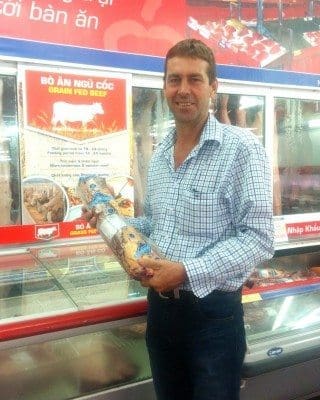A Government-imposed limit on live cattle exports, as suggested by the union representing Australian meat workers, is not the solution, because live cattle exports are not the problem, the Australian Livestock Exporters’ Council said in a return fire statement today.
Yesterday the Australian Meat Industry Employee’s Union launched an attack on the live cattle export industry which it blames for the extended closure of the JBS-owned Townsville abattoir, and called for a cap on live export volumes.
However ALEC CEO Alison Penfold said the AMIEU’s claims were off target.
“Tough seasonal conditions due to drought, high input costs and a sluggish global market for beef are the key issues affecting decisions for not only northern abattoirs but for livestock exporters too.
“At the same time that live exporters have been active in purchasing suitable stock in northern Australia, massive numbers of cattle have been processed domestically with the national cattle herd plummeting to a 20-year low.
“In relative terms, 87 per cent of Australia’s overall 2015 cattle turnoff – some 9 million head of cattle – were processed domestically.
“It is also important to understand that the live trade sources different lines of cattle which are predominantly younger and lighter to those processed at abattoirs like the one at Townsville.
“This is because our customers in Asia prefer smaller, lighter cattle rather than the larger, heavier bullocks which are the mainstay of the processing sector in northern Australia.
“Live exported cattle are slaughtered in the early hours of the morning, the beef in wet markets shortly after and in soups and stews by breakfast. This is the food security story that Australia is supporting.
“In addition, it must be noted that many Queensland cattle that were previously shipped out of Darwin have been shipped out of Townsville more recently, as a means of reducing transport distances and utilising port capacity in Townsville.
“This is a good thing for the local economy in northern Queensland.”
Ms Penfold expressed concern for the abattoir employees during this period of uncertainty.
“This is obviously a tough time for the workers affected by the decisions of local processors, just as it was a tough time for producers not that long ago who were enduring low cattle prices,” she said.
“I believe the red meat sector is best served by a strong live export and boxed sector that maximises opportunities for producers with a wide range of market options, which in turn promotes growth and improvements in our production capacity and increases the overall economic value of the beef cattle industry.
“The strong livestock export figures for the 2015 calendar year released last week by MLA confirm significant contribution the livestock export industry is making to the economy, to regional jobs and to leading improvements in our overseas markets in infrastructure, handling and in-market slaughter practices.
“Rather than laying blame at the feet of live exporters out of convenience, there should be a greater focus on the removal of unnecessary regulatory costs and inefficiencies that challenge the sectors productivity, act as disincentives to innovate and place the entire red meat sector at a competitive disadvantage to our overseas competitors.
“In this context, more regulation via heavy-handed market inference by the governments clearly isn’t the answer. Exporters are naturally wary of any suggestions about caps on export numbers given the last time we saw government interference of this nature it effectively came in the form of the ban of cattle exports to Indonesia in 2011, which had a devastating and long-lasting effect impact on exporters, producers, stockmen, transport operators and the many other people involved in the trade.
“Australia’s red meat supply chain draws much of its long-term resilience on the integrated way in which all players in the sector cooperate. Such integration, which is a pillar of the national red meat sector’s strategic accord, is a significant strength and helps us to grow our overall red meat production and output for the benefit of all stakeholders.”
Focus on the long-term vision, urges CCA
Meanwhile, Cattle Council of Australia has called for calm and a focus on the long-term vision for the Australian beef industry, following calls for Government intervention in Australia’s beef supply chains.
Any suggestion that there should be market intervention at any point in Australia’s beef supply chain, either domestically or internationally, would be strongly apposed by Australian beef producers, CCA warned.
“Australian beef producers are strong supporters of free markets” CCA president Howard Smith said.
“Government intervention at any point in the supply chain will inevitably create market failure, which will ultimately harm cattle producers” said Mr Smith.
Cattle Council said it recognised that the processing sector was currently managing the decline in cattle numbers, but it was essential to the profitability of the whole Australian beef industry that a long-term vision is maintained.
“Beef producers must have access to multiple markets that are globally competitive to ensure the long-term sustainability of the industry. It is vital that both the processor and live export supply chains are healthy and open to the free market,” Mr Smith said.
“The whole beef industry must work together to ensure that all supply chains are as efficient and competitive. Only through greater collaboration, throughout the whole supply chain, can the beef industry reduce the peaks and troughs that we all experience.”
The Australian beef industry has always been subject to ebbs and flows in supply and demand for both cattle and beef. This results in differing points in the supply chain being more profitable than others at various times.
Market conditions can never be attributed to any one factor. Seasonal conditions, global supply, exchange rates and market access all contribute to the price paid for cattle and beef at any one time.
“We are entering an unprecedented period of global demand for protein. We must not put constraints on our supply chains, we must invest in them and remove impediments so they can prosper and create jobs,” Mr Smith said.
Source: ALEC, CCA


